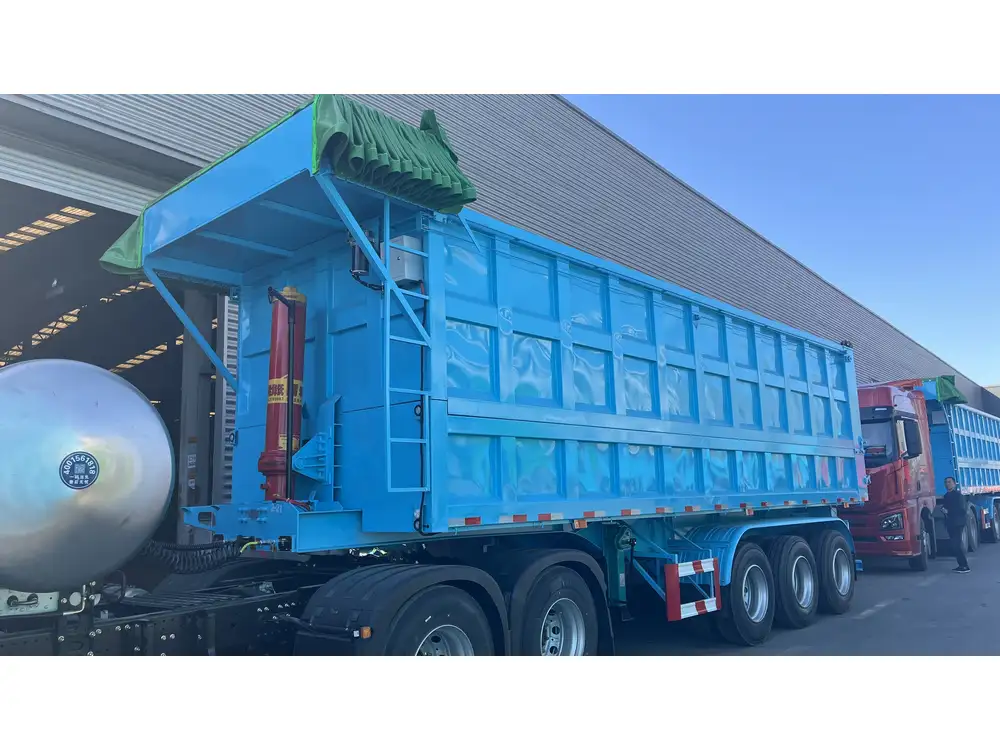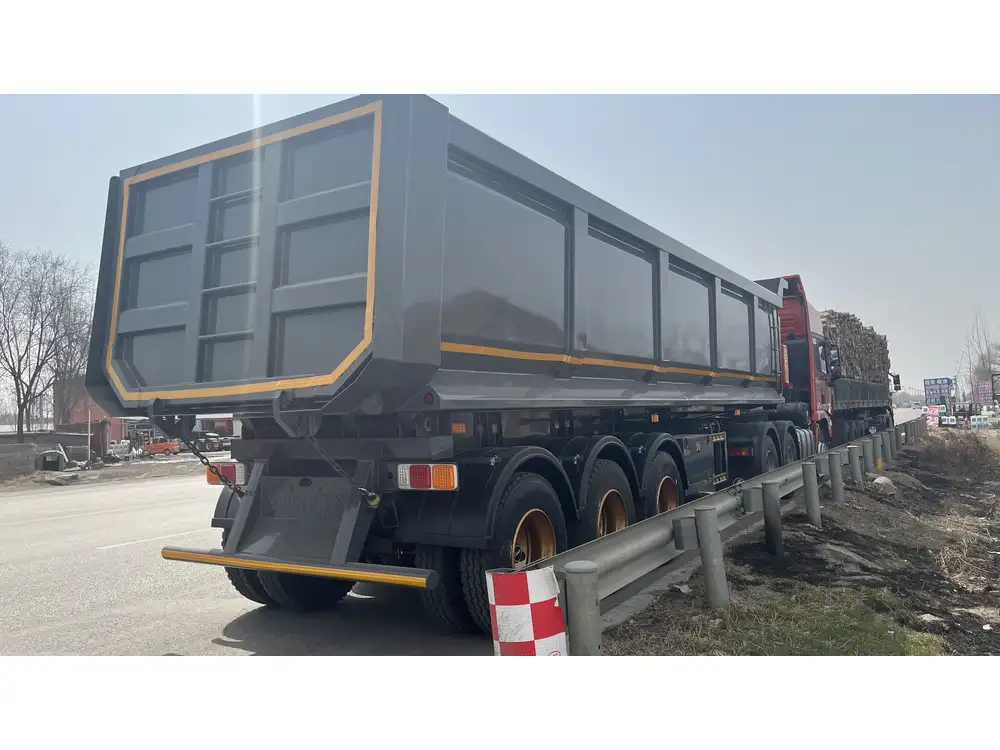Overview of Semi Dump Trailers
Semi dump trailers, also known as dump trailers, are indispensable in the construction and hauling industries. They come equipped with hydraulic systems that allow the trailer bed to tip, enabling a smooth and efficient unloading process. Commonly utilized for transporting aggregates, dirt, gravel, and construction debris, these trailers vary in size and specifications, greatly impacting their load capacities and real-world applications.
What is the Capacity of a Semi Dump Trailer?

Typical Load Capacities
When assessing “how many yards does a semi dump trailer hold?”, it is crucial to consider multiple factors, including the trailer’s size, design, and intended use. Standard semi dump trailers are generally designed to accommodate 10 to 20 cubic yards of material. Below is a detailed classification based on specific trailer dimensions:
| Trailer Size | Approximate Volume (Cubic Yards) |
|---|---|
| 14-foot trailer | 10 – 12 cubic yards |
| 16-foot trailer | 14 – 16 cubic yards |
| 20-foot trailer | 18 – 20 cubic yards |
Factors Influencing Capacity
Dimensions and Design: Not all semi dump trailers are built the same. The length, width, and height of the trailer directly influence how much material can be safely transported.
Material Type: The type of material also plays a significant role. For instance:
- Loose Aggregates: This material may have a bulk density that allows for a greater volume in cubic yards.
- Heavy Materials: Concrete or machinery greatly reduce the number of cubic yards that can be carried due to their weight.
Regulatory Restrictions: Trucking regulations often limit the maximum weight that can be transported on public roadways, which may impact the effective load capacity in practice.
Weight Distribution: Proper weight distribution must always be considered. An imbalanced load can lead to safety hazards and reduce overall hauling efficiency.
Key Specifications to Consider
When choosing a semi dump trailer, various specifications will affect its practicality and efficiency on site. Here are some critical specs to analyze:
| Specification | Details |
|---|---|
| GVRW (Gross Vehicle Weight Rating) | Varies by trailer design, usually ranges from 24,000 lbs to 34,000 lbs for heavy-duty models. |
| Axle Configuration | Common configurations include tandem and tri-axle setups to enhance load stability. |
| Hydraulic System | Single-acting or double-acting cylinders may be employed, affecting lifting speed and capacity. |
| Material | Aluminum vs. Steel: Aluminum models are lighter and resistant to corrosion; however, steel offers robustness at a lower cost. |

Common Uses of Semi Dump Trailers
Hauling Construction Materials
The pivotal role of semi dump trailers in construction cannot be overstated. Their primary use is transporting:
- Earthfill: For grading and excavating projects.
- Sand and Gravel: Essential for concrete mixing and road building.
- Asphalt: Critical for road construction and repairs.
Agriculture and Landscaping
In agriculture, these trailers are frequently used for hauling soil amendments, mulch, and other landscape materials. The versatility of semi dump trailers makes them an ideal choice for both rural and urban landscaping projects.

Demolition and Recycling
In the demolition industry, semi dump trailers are vital for transporting debris away from job sites. Their hydraulic lifting capabilities offer an advantage when unloading heavy materials quickly.
Benefits of Using a Semi Dump Trailer
Enhanced Efficiency
The hydraulic capabilities of semi dump trailers facilitate faster unloading, significantly improving operational efficiency on jobsites. This time-saving feature minimizes downtime, allowing for more work to be completed in less time.

Improved Load Management
With the ability to adjust load sizes according to specific project needs, semi dump trailers provide flexibility that enhances productivity. Their design permits easy handling of various material types without requiring multiple trips back to the loading site.
Durability and Longevity
Constructed with resilience in mind, properly maintained semi dump trailers can ensure long years of service. Many manufacturers use high-grade steel or aluminum that withstands wear and tear from heavy loads and adverse weather.
Maintenance Tips for Semi Dump Trailers
Proper maintenance prolongs the lifespan and efficiency of your semi dump trailer. Here are essential maintenance tips:
Regular Inspections: Conduct regular visual inspections to identify signs of wear or damage, especially on the hydraulic system and trailer’s frame.
Hydraulic System Maintenance:
- Check hydraulic fluid levels regularly and ensure there are no leaks.
- Perform routine checks on hoses and connections for any signs of wear.
Tire Care:
- Monitor tire pressure according to manufacturer specifications.
- Inspect for uneven wear that could signal alignment issues.
Cleaning:
- Clean the trailer bed after each use to prevent material buildup, which can lead to corrosion over time.
Lubrication: Regularly lubricate the moving parts and joints to minimize friction and ensure smooth operation.

Selecting the Right Semi Dump Trailer: A Comparative Analysis
When considering purchasing a semi dump trailer, multiple factors will influence your decision. Below is a comparative overview to assist in making an informed choice:
| Factor | Steel Trailers | Aluminum Trailers |
|---|---|---|
| Weight | Heavier, adds to load capacity (often heavier load limits) | Lighter, enhances fuel efficiency and payload capacity |
| Cost | Typically more affordable initially | Generally higher initial cost, but provides long-term savings due to durability and maintenance |
| Resistance to Corrosion | Requires protection and regular maintenance against rust | Naturally resistant, requires less maintenance |
| Durability | Offers robustness against harsh conditions | Subject to dent but highly resistant to environmental wear |
Storage Considerations for Semi Dump Trailers
When it’s time to store your semi dump trailer, keep the following best practices in mind:
- Clean the Trailer: Remove any material residue and wash to prevent corrosion.
- Choose a Covered Area: Whenever possible, store your trailer in a shaded or covered area to protect it from the elements.
- Check the Tires: Inflate to recommended pressure and consider using tire cradles to prevent flat spots.
Conclusion: Choosing the Proper Semi Dump Trailer for Your Needs
In summary, understanding the dimensions, capacities, and functionalities of semi dump trailers allows for informed decision-making when it comes to choosing the right trailer for your specific needs. By knowing the specific utility of these trailers and their impact on your workflow, you ensure you optimize every transportation requirement efficiently and effectively.
Emphasizing proper maintenance practices and leveraging the unique advantages offered by either steel or aluminum options can lead to improved performance and longevity. This decision ultimately guarantees that your semi dump trailer meets the demanding challenges of your industry, whether in construction, agriculture, or logistics.



